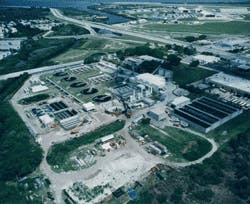Deep Bed Denitrification Filters Continue to Play Major Role in Improved Wastewater Quality Nationwi
Deep bed denitrification filters have proven to be a highly effective treatment technology used by wastewater plants to meet low total nitrogen (TN) limits. The combination of denitrification and solids removal in a deep bed filter process was first patented in 1979, and since then, the technology has been responsible for helping to dramatically improve wastewater quality at treatment plants across the country.
When full nitrogen removal is required, one of the available treatment methods is biological denitrification. During this form of denitrification, nitrate-nitrogen is biologically converted into nitrogen gas, thus playing an integral role in maintaining the integrity of the wastewater treatment plant’s receiving waters.
Deep bed filtration
Filtering liquids through deep beds of porous granular media to improve their clarity is a treatment process often used in tertiary wastewater filtration for reuse.
Additionally, the removal of nutrients provides advanced wastewater treatment quality effluent. In an increasingly demanding and price-conscious industry, fixed-film biological denitrification technologies have proven their efficiency and cost-effectiveness at treatment plants across the country.
The Tetra Denite process from Severn Trent Services is one example of an economic and efficient use of deep bed filtration technology in the denitrification process. The Tetra Denite system combines deep bed filtration and fixed-film biological denitrification to achieve a high level of process synergy while acting as both a bioreactor and effluent filter. Simultaneous removal of total suspended solids (TSS) and nitrate-nitrogen achieves 1ppm nitrate-nitrogen and 3 ppm total nitrogen or less.
The city of Largo Advanced Wastewater Treatment Facility has nine denitrification filters, each 10 x 60 ft. Six feet of large, rounded sand media provide long run times, depth storage of TSS and attachment room for denitrifying biomass.
Concrete underdrain blocks support the gravel and media, while simultaneously protecting a grid of stainless steel air laterals. This underdrain configuration with large passages that resist clogging from biomass and TSS is ideally suited for use in wastewater treatment facilities.
Vigorous simultaneous air/water backwash at a relatively low backwash water rate consumes only about 2% of forward flow (much lower than other filter types). Between 1997 and 2001, Largo’s effluent operating data showed an average flow of 12.5 mgd, BOD of 2.17 mg/L, Total-N of 1.71 mg/L and TSS of 0.65 mg/L.
Scituate, Mass.
The Scituate Advanced Wastewater Treatment Facility uses four 9.5 x 32 ft deep bed filters and employs the TetraPace automatic dose control system. This system uses plant flow, influent and effluent nitrate-nitrogen to pace methanol dosage.
This plant is notable for the excellent cold weather performance of its denitrification filters. Daily data collected over the period from Nov. 11, 2003 to Jan. 31, 2004 showed very consistent denitrification to below 0.5 mg/L nitrate-nitrogen. The last month of data was at a wastewater temperature of about 8o C.
Averaging all data revealed the following results during this period: average flow of 1.31 mgd; water temperature of 11.7oC; influent nitrate-nitrogen of 10.2 mg/L; and effluent nitrate-nitrogen of 0.50 mg/L.
Table 1: Cold Weather Performance Data- Northeast US (Monthly Averages)
| Mgd | Wastewater Temperature degrees C | Influent NO3-N Mg/l | Effluent NO3-N mg/l |
| 1.01 | 14.9 | 11.56 | 0.45 |
| 1.77 | 11.6 | 8.25 | 0.47 |
| 1.13 | 8.5 | 10.91 | 0.48 |
| 1.0 | 8 | 13 | 0.5 |
| 2.36 | 8 | 11 | 0.5 |
It was constructed in 1978 with 20 10 x 105 ft filters. Twelve filters of similar size were added in 1992.
The improvement in filtered effluent quality of the large flow from this plant has been a documented factor in the revitalization of Tampa Bay over the last few decades. Sea grasses, turtle grasses and sport fish have returned to once barren areas of this Outstanding Florida Waterway.
Five years of effluent data (1997-2001) reveal the following results: average flow of 53.4 mgd; BOD of 2.52 mg/L; Total-N of 2.5 mg/L; and TSS of 0.96 mg/L.
Table 2: Howard Curren AWTP- Tampa, Fla. (100 mgd)
| Period | mgd | BOD (mg/l) | SS (mg/l) | TN (mg/l) | TKN (mg/l) | NH3-N (mg/l) | NOx-N (mg/l) |
| 1980-1988 | 51.3 | 3.4 | 2.8 | .2.8 | .17 | .17 | 1.06 |
| 1989-1998 | 55.5 | 2.4 | 1.6 | 2.4 | 1.56 | .18 | 0.87 |
| 1999 | 50.45 | 2.6 | 0.9 | 2.52 | 1.46 | .13 | 1.01 |
| 2000 | 48.5 | 3.1 | 0.7 | 2.24 | 1.29 | .14 | 0.95 |
| 2001 | 49.7 | 2.3 | 0.8 | 2.28 | 1.21 | .15 | 1.06 |
| Average | 51.0 | 2.76 | 1.4 | 2.4 | 1.5 | .15 | 0.99 |
In light of more stringent regulations, fixed-film biological deep bed denitrification filters continue to set the standard for meeting low total nitrogen limits.
